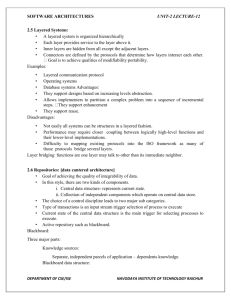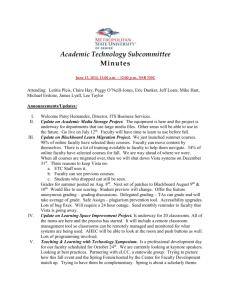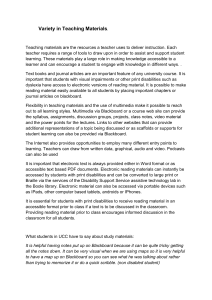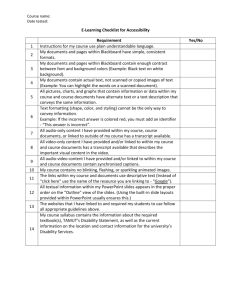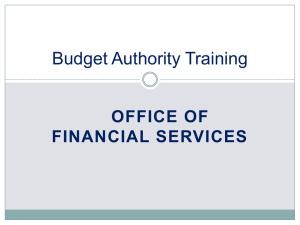- Navodaya Institute of Technology, Raichur
advertisement
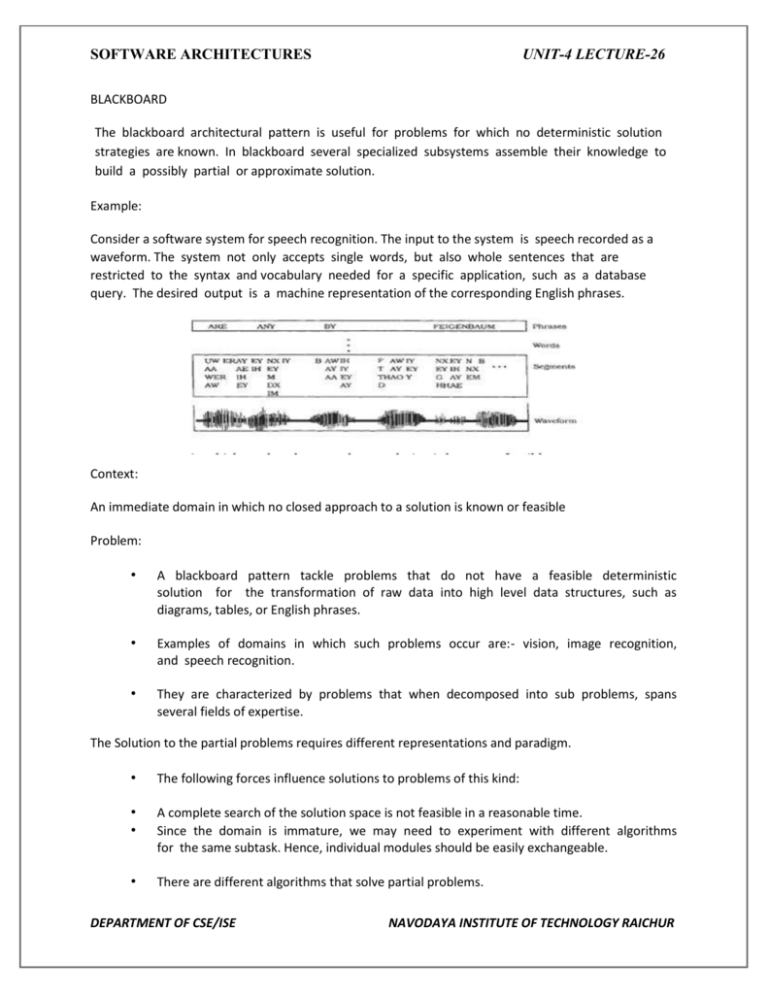
SOFTWARE ARCHITECTURES UNIT-4 LECTURE-26 BLACKBOARD The blackboard architectural pattern is useful for problems for which no deterministic solution strategies are known. In blackboard several specialized subsystems assemble their knowledge to build a possibly partial or approximate solution. Example: Consider a software system for speech recognition. The input to the system is speech recorded as a waveform. The system not only accepts single words, but also whole sentences that are restricted to the syntax and vocabulary needed for a specific application, such as a database query. The desired output is a machine representation of the corresponding English phrases. Context: An immediate domain in which no closed approach to a solution is known or feasible Problem: • A blackboard pattern tackle problems that do not have a feasible deterministic solution for the transformation of raw data into high level data structures, such as diagrams, tables, or English phrases. • Examples of domains in which such problems occur are:- vision, image recognition, and speech recognition. • They are characterized by problems that when decomposed into sub problems, spans several fields of expertise. The Solution to the partial problems requires different representations and paradigm. • The following forces influence solutions to problems of this kind: • • A complete search of the solution space is not feasible in a reasonable time. Since the domain is immature, we may need to experiment with different algorithms for the same subtask. Hence, individual modules should be easily exchangeable. • There are different algorithms that solve partial problems. DEPARTMENT OF CSE/ISE NAVODAYA INSTITUTE OF TECHNOLOGY RAICHUR SOFTWARE ARCHITECTURES • UNIT-4 LECTURE-26 Input as well as intermediate and final results, have different representation, and the algorithms are implemented according to different paradigms. An algorithm usually works on the results of other algorithms. Uncertain data and approximate solutions are involved. Employing dis fact algorithms induces potential parallelism. Solution: The idea behind the blackboard architecture is a collection of independent programs that work co operatively on a common data structure. • Each program is meant for solving a particular part of overall task. • These programs are independent of each other they do not call each other, nor there is a predefined sequence for their activation. Instead, the direction taken by the system is mainly determined by the current state of progress. • A central control component evaluates the current state of processing and coordinates these programs. • These data directed control regime is referred to as opportunistic problem solving. • The set of all possible solutions is called solution space and is organized into levels of abstraction. • The name 'blackboard’ was chosen because it is reminiscent of the situation in which human experts sit in front of a real blackboard and work together to solve a problem. • Each expert separately evaluates the current state of the solution, and may go up to the blackboard at any time and add, change or delete information. • Humans usually decide themselves who has the next access to the blackboard. Structure: Divide your system into a component called a blackboard, a collection of knowledge sources, and a control component. Blackboard: o Blackboard is the central data store. o Elements of the solution space and control data are stored here. o Set of all data elements that can appear on the blackboard are referred to as vocabulary. DEPARTMENT OF CSE/ISE NAVODAYA INSTITUTE OF TECHNOLOGY RAICHUR SOFTWARE ARCHITECTURES UNIT-4 LECTURE-26 o Blackboard provides an interface that enables all knowledge sources to read form and write to it. o We use the terms hypothesis or blackboard entry for solutions that are constructed during the problem solving process and put on the blackboard. o A hypothesis has several attributes, ex: its abstraction level. Knowledge source: • Knowledge sources are separate, independent subsystem that solve specific aspects of the overall problem. • Knowledge sources do not communicate directly they only read from and write to the blackboard. • Often a knowledge source operates on two levels of abstraction. • Each knowledge source is responsible for knowing the conditions under which it can contribute to a solution. Hence, knowledge sources are split into. • Condition part: evaluates the current state of the solution process, as written on the blackboard, to determine if it can make a contribution. • Action part: produces a result that may causes a change to the blackboard’s content Control component: DEPARTMENT OF CSE/ISE NAVODAYA INSTITUTE OF TECHNOLOGY RAICHUR SOFTWARE ARCHITECTURES UNIT-4 LECTURE-26 • Runs a loop that monitors the changes on the blackboard and decides what action to take next. • It schedules knowledge source evaluations and activations according to the knowledge applications strategy. The basis for this strategy is the data on the blackboard. DEPARTMENT OF CSE/ISE NAVODAYA INSTITUTE OF TECHNOLOGY RAICHUR
